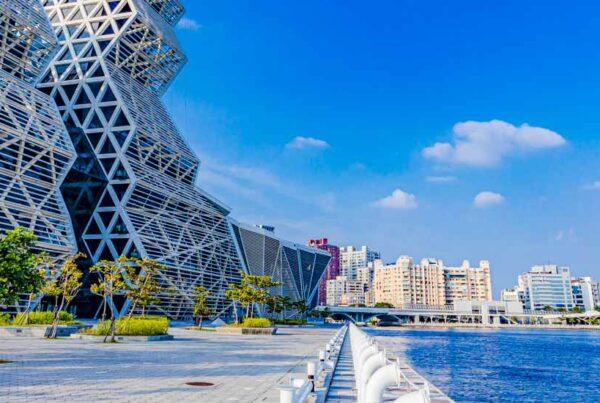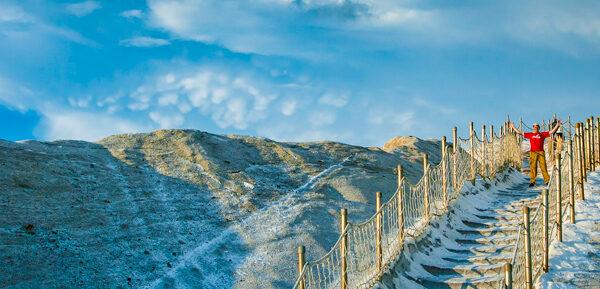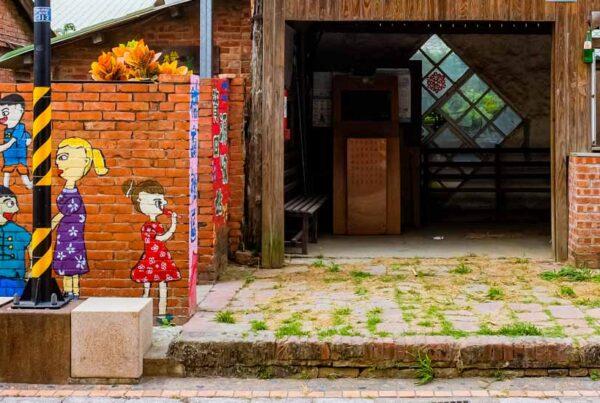Experiencing Traditional Culture in Xingang Township and Chiayi City
TEXT / STEVEN CROOK
PHOTOS / ALAN WEN, VISION
Traveling from Taipei in the north, in their eagerness to reach the mountainous Alishan National Scenic Area or the city of Tainan many international travelers spend no more than an hour in Chiayi City, or bypass it altogether. This low-rise city of 264,000 people is much more than a transportation hub, however, and discerning tourists are starting to recognize that its museums, temples, culturally-rich hinterland, and other attractions more than justify an overnight stay.
Han Chinese migrants who began arriving in southern Taiwan in the 17th century set about converting much of the region around Chiayi into rice paddies. Certain villages grew into market towns or became fixtures on pilgrimage routes. One settlement that has retained its prominence is Xingang, about 14km northwest of Chiayi City, or 40-odd minutes by public bus (nos. 7201, 7202, or 7235).
Xingang Township
Fengtian Temple
Since 1988, Xingang’s Fengtian Temple has been where pilgrims taking part in the famed annual springtime Mazu celebration procession from Dajia Jenn Lann Temple in Taichung City turn around and begin the return leg of their epic nine-day, 300-plus-kilometer journey. Like Jenn Lann Temple, Fengtian Temple exists to honor Mazu, the fisherman’s daughter from Fujian Province in China who became the Chinese Goddess of the Sea. In modern Taiwan, she’s perhaps more revered than any other deity.


Jealousy has no place in Taiwanese popular religion, and many of those who pray to Mazu at Fengtian Temple also offer incense to the shrine’s other resident divinities, among them Guan Gong.
More unusual is the local practice of honoring the Tiger General. Effigies of this divinity, sometimes called the Tiger Lord, can be seen at numerous shrines around the island. But only here is he elevated from his usual floor-level position and given an altar and chamber of his own, labeled Hu Ye Dian or “Tiger Lord Chamber” in Chinese (no English).
Followers of the Tiger General first humbly present incense, joss paper, and the deity’s favorite food: raw eggs. Then, from a water-filled basin on the altar, they pluck two NT$1 coins – never more, never less – which they seal in a plastic bag along with a scoop of the water. Sprinkling this liquid around one’s house three days later, it’s believed, will ensure the Tiger General’s support in matters of business and finance.

Devotees of the Tiger General celebrate his birthday on the sixth day of the sixth lunar month, but there are even better opportunities to appreciate the vibrant nature of local religious worship. One is the day on which Fengtian Temple receives those who’ve walked all the way from Dajia. Politicians attend, as do thousands of local residents, while volunteers distribute food and supplies to the pilgrims. The actual birthday of Mazu (the 23rd day of the third lunar month) is another time when you’ll see both somber rites and exuberant festivities. To confirm the 2024 dates, contact the Taiwan Tourism Administration or get a Mandarin speaker to call the temple.

Xingang Fengtian Temple
(新港奉天宮)
Tel: (05) 374-2034
Add: No.53, Xinmin Rd., Xingang Township, Chiayi County
(嘉義縣新港鄉新民路53號)
Website: www.hsinkangmazu.org.tw (Chinese)
Bantaoyao Crafts Studio of Jiao-Zhi Pottery & Chien-Nien
Mazu has been worshiped at Fengtian Temple since at least 1811, and the current iteration of the temple is a treasure house of traditional artistic expression, crowded with detailed paintings, carvings, and ceramic figurines.

To see how such images and objects are produced, there are few places better than Bantaoyao Crafts Studio of Jiao-Zhi Pottery & Chien-Nien. Located less than 4km west of Fengtian Temple, this family-friendly operation was established to promote and preserve the ancient arts of jiaozhi pottery (often also called koji pottery in English) and jiannian decoration.


The former is an exceptionally ornate and colorful form of art in which the Chiayi area is considered to be preeminent. The latter is a cut-and-glue method that utilizes fragments of colored glass and earthenware to create representations of characters from folktales and auspicious symbols such as pagodas and dragons.
For visitors, there are opportunities to watch masters at work, and to try their hand at creating mosaic art or painting ceramic dolls. Even if you pass up the chance to make something of your own, there’s a good chance you’ll find some excellent souvenirs. Some of the items on sale are utterly traditional in appearance, while others reflect modern ideas of what’s cute and charming.


Not everything here revolves around art. You can also press sesame seeds for oil or grind them into a paste that lends one of Taiwan’s most popular noodle dishes its distinctive flavor. The on-site restaurant/café serves hot pot, light meals, and a range of beverages. If you’re not hungry or thirsty, and have no desire to weigh yourself down with keepsakes, it’s still easy to spend a lot of time here, taking in the countless objets d’art on display throughout the site. Kids adore the cats, dinosaurs, rabbits, and other ceramic animals.


Admission is NT$100, half of which is redeemable against purchases of food, drinks, souvenirs, or activities. The complex is open 9:30am to 5:30pm daily. Set aside some time to explore the surrounding community, where traces of Taiwan’s once-mighty sugar industry can be found alongside murals and other public art.

Bantaoyao Crafts Studio of Jiao-Zhi Pottery & Chien-Nien
(板陶窯交趾剪黏工藝園區)
Tel: (05) 781-0832
Add: No.45-1, Bantou Village, Xingang Township, Chiayi County
(嘉義縣新港鄉板頭村45-1號)
Website: www.bantaoyao.com.tw (Chinese)
Singang Incense Artistic Culture Garden
Jiaozhi and jiannian works are once-in-a-century investments for temples. By contrast, even the humblest believer requires a steady supply of incense for rituals. This fragrant substance is an ever-present element in Taiwanese religious life. Individuals who make pilgrimages to distant temples are called xiangke (“guests bearing incense”).



Facing competitive pressures from low-cost producers in other countries, the brothers who established what’s now called Singang Incense Artistic Culture Garden decided to up their game and turn their incense-manufacturing operation into a place of culture and education.
Elevating traditional incense-making into a new form of aromatic art, the garden includes an exhibition that explores the uses of incense by followers of different religions around the world, as well as the various raw materials from which it’s made. Of course, not all incenses are equal: the versions sold here vary greatly in fragrance and price.




Whether you’re a local day-tripper or a tourist who’s come from afar, you can try to create something unique as well. It doesn’t take long to judge how to combine incense powder and water in just the right proportions so the mixture can be kneaded and given an artistic shape. Unlike with pottery, there’s no need to fire a completed work. It’ll very soon harden naturally, meaning you can take it home (or back to your hotel).

The olfactory delight that is Singang Incense Artistic Culture Garden is open 8am to 6pm daily. Located on the main road leading to Chiayi City, a short walk from a bus stop, it also has a restaurant. The garden doesn’t charge for admission, and parking is free.
Singang Incense Artistic Culture Garden
(新港香藝文化園區)
Tel: (05) 374-0007
Add: No.23-6, Caigong Village, Xingang Township, Chiayi County
(嘉義縣新港鄉菜公村23-6號)
Facebook: www.facebook.com/incenseart
Website: www.incense-art.com.tw (Chinese)
Chiayi City
Chiayi Municipal Museum
The city itself has two museums that should appeal to anyone with an interest in Taiwan culture and history. They’re not only close to each other, but also within walking distance of the train and bus stations.
Chiayi Municipal Museum isn’t so big that you’ll suffer from information overload, yet it manages to provide a comprehensive overview of the city’s long history. In fact, if you’re going to be spending at least one full day in Chiayi, you may want to come here first. It introduces local places of worship and other interesting spots, such as the decommissioned old prison, that you may want to add to your itinerary.


The first floor is a venue for temporary exhibitions, while the second floor explores the development of what was once called Zhuluo, which later earned the name Chiayi (“commendable righteousness”) thanks to its steadfast loyalty to the imperial authorities during a major uprising. The huge model of the city, which introduces its landmarks and notable industries, is quite impressive.


Even if you don’t much care for history lessons, do try to see everything on this floor, as the sections on traditional businesses and local foods may well grab your attention. In the Chiayi of yore, many shops specialized in tinware and woodcarving (for ancestor shrines and temples), picture framing, incense for ritual purposes, and paper-and-bamboo lanterns. Herbal apothecaries treated the sick. Among Chiayi’s signature dishes are shredded turkey on rice and fish head casserole.


Culture vultures are likely to spend more time on the third floor, where the permanent exhibition is titled Architectural Theater: Story Time with Temple Figurines. If English is your only language, this is probably the best place in Taiwan to learn about the origins of jiaozhi pottery, its masters, and the themes and characters often depicted in jiaozhi works. The explanation of how jiaozhi art is created is detailed and accompanied by examples of preliminary sketches, figurine torsos before and after hollowing, and the glazes that give these masterpieces their dazzling appearance.

You’ll quickly appreciate that jiaozhi artists must excel not only at kneading clay, but also at drawing, mixing colors, painting, and firing. And that’s before you’ve examined the stunning works displayed here, many of which convey Confucian, Daoist, or Buddhist messages. There are also personalities from literature and legends, in addition to animals and objects which symbolize good luck.
The museum is open 9am to 5pm Tuesday to Sunday; admission is NT$50.
Chiayi Municipal Museum
(嘉義市立博物館)
Tel: (05) 278-0303
Add: No.275-1, Zhongxiao Rd., East District, Chiayi City
(嘉義市東區忠孝路275-1號)
Website: museum.chiayi.gov.tw
Museum of Old Taiwan Tiles
Similar motifs appear in two-dimensional form inside the Museum of Old Taiwan Tiles, 900m from Chiayi Municipal Museum. Founded by a Chiayi native who realized that a form of decoration favored by Taiwan’s wealthier families between the 1880s and 1930s was in danger of disappearing, this museum preserves exquisite tiles salvaged from houses undergoing demolition. It also gives a new generation of tile artists a way to connect with the public.


Most of these tiles are square, 15.2cm by 15.2cm, and bear stand-alone patterns, typically of flowers or fruit. Others, when arranged in grids, create larger pictures. These are often scenes from the classics of Chinese literature, but one set rescued from an old residence in Tainan – and now displayed just inside the museum’s entrance – presents Mount Fuji. The house was built during Taiwan’s 1895~1945 period of Japanese rule, during which many locals looked up to their colonial masters.


While you’re inside, do also pay attention to the building itself, its antique furniture, and the retro fittings. As in many shophouses built 60 or more years ago, the roof is held up by wooden beams. In very few, however, have they been so beautifully restored and left visible. On the second floor and the mezzanine third floor (sleeping quarters in the old days), you may well find yourself lingering for a good while.


The Museum of Old Taiwan Tiles is open from 10am to 5:30pm Wednesday to Monday. Admission is NT$100, which you’ll get back if you make a purchase inside. If you’re looking to buy a gift for someone, there are ceramic coasters plus decorative items with modern designs. If you’re seeking something with a distinct Taiwan flavor, consider the tiles which feature black bears, black-faced spoonbills, and other iconic creatures. International travelers hoping to learn as much as possible should arrange to visit with a Mandarin speaker, as most of the information presented inside is in Chinese only.

Museum of Old Taiwan Tiles
(台灣花磚博物館)
Tel: 0905-012-390
Add: No.282, Linsen W. Rd., West District, Chiayi City
(嘉義市西區林森西路282號)
Website: www.1920t.com (Chinese)
About the author

Steven Crook
Steven Crook, who grew up in England, first arrived in Taiwan in 1991. Since 1996, he’s been writing about Taiwan’s natural and cultural attractions for newspapers and magazines, including CNN Traveler Asia-Pacific, Christian Science Monitor, and various inflight magazines. He’s the author of four books about the country: Keeping Up With The War God (2001), Dos And Don’ts In Taiwan (2010), Taiwan: The Bradt Travel Guide (2010), and A Culinary History of Taipei: Beyond Pork and Ponlai (2018)
http://crooksteven.blogspot.com
http://bradttaiwan.blogspot.com







































